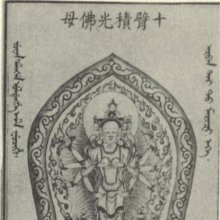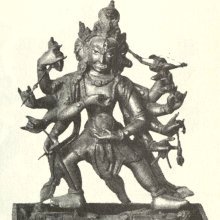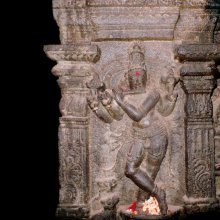Dashabhuja, Daśabhujā, Dashan-bhuja, Daśabhuja, Dasha-bhuja: 7 definitions
Introduction:
Dashabhuja means something in Hinduism, Sanskrit. If you want to know the exact meaning, history, etymology or English translation of this term then check out the descriptions on this page. Add your comment or reference to a book if you want to contribute to this summary article.
The Sanskrit terms Daśabhujā and Daśabhuja can be transliterated into English as Dasabhuja or Dashabhuja, using the IAST transliteration scheme (?).
Images (photo gallery)
In Hinduism
Purana and Itihasa (epic history)
Source: archive.org: Shiva Purana - English TranslationDaśabhuja (दशभुज) refers to “one who has ten arms” and is used to describe Śiva, according to the Śivapurāṇa 2.3.27 (“Description of the fraudulent words of the Brahmacārin”).—Accordingly, as Śiva (in guise of a Brahmacārin) said to Pārvatī: “[...] I know Śiva through and through with all His weighty attributes. I shall tell you the truth. Listen with attention. [...] He holds the skull. Serpents twine round His limbs. Poison has left a mark on his neck. He eats even forbidden stuffs. He has odd eyes and is definitely awful. His birth and pedigree cannot be traced. He is devoid of the enjoyment of a householder. He has ten arms [i.e., daśabhuja]. He is mostly naked and is ever accompanied by ghosts and goblins. [...]”.
Source: JatLand: List of Mahabharata people and placesDaśabhuja (दशभुज) is a name mentioned in the Mahābhārata (cf. XIV.8) and represents one of the many proper names used for people and places. Note: The Mahābhārata (mentioning Daśa-bhuja) is a Sanskrit epic poem consisting of 100,000 ślokas (metrical verses) and is over 2000 years old.

The Purana (पुराण, purāṇas) refers to Sanskrit literature preserving ancient India’s vast cultural history, including historical legends, religious ceremonies, various arts and sciences. The eighteen mahapuranas total over 400,000 shlokas (metrical couplets) and date to at least several centuries BCE.
Shaktism (Shakta philosophy)
Source: Google Books: ManthanabhairavatantramDaśabhujā (दशभुजा) refers to “she who has ten arms”, according to the Manthānabhairavatantra, a vast sprawling work that belongs to a corpus of Tantric texts concerned with the worship of the goddess Kubjikā.—Accordingly, “ (Pūrṇacandrā), the goddess who resides in the door in the north is Pūrṇā Maṅgalā. She has five faces and ten arms [i.e., daśabhujā] and sits on a lion. She wears the full moon on her head. The left hands make gestures of fearlessness and boon bestowal, and hold a mirror, a noose, and goad. In the right hands she holds a dagger, bow, sword, pestle, and a fearsome spear. She bestows boons in the north”.

Shakta (शाक्त, śākta) or Shaktism (śāktism) represents a tradition of Hinduism where the Goddess (Devi) is revered and worshipped. Shakta literature includes a range of scriptures, including various Agamas and Tantras, although its roots may be traced back to the Vedas.
Languages of India and abroad
Sanskrit dictionary
Source: DDSA: The practical Sanskrit-English dictionaryDaśabhujā (दशभुजा).—Name of Durgā.
Daśabhujā is a Sanskrit compound consisting of the terms daśan and bhujā (भुजा). See also (synonyms): daśamahāvidyā.
Source: Cologne Digital Sanskrit Dictionaries: Monier-Williams Sanskrit-English DictionaryDaśabhujā (दशभुजा):—[=daśa-bhujā] [from daśa] f. ‘ten-armed’, Durgā, [Kālikā-purāṇa]
[Sanskrit to German]
Sanskrit, also spelled संस्कृतम् (saṃskṛtam), is an ancient language of India commonly seen as the grandmother of the Indo-European language family (even English!). Closely allied with Prakrit and Pali, Sanskrit is more exhaustive in both grammar and terms and has the most extensive collection of literature in the world, greatly surpassing its sister-languages Greek and Latin.
See also (Relevant definitions)
Partial matches: Dasa, Bhuja, Tacan, Taca.
Starts with: Dashabhujasita, Dashabhujasitamarici.
Ends with: Ashtadashabhuja, Dvadashabhuja, Shodashabhuja.
Full-text: Dvadashabhuja, Dashamahavidya.
Relevant text
Search found 4 books and stories containing Dashabhuja, Daśabhujā, Dashan-bhuja, Daśan-bhujā, Dasabhuja, Dasan-bhuja, Daśabhuja, Dasha-bhuja, Daśa-bhuja, Dasa-bhuja, Daśa-bhujā; (plurals include: Dashabhujas, Daśabhujās, bhujas, bhujās, Dasabhujas, Daśabhujas). You can also click to the full overview containing English textual excerpts. Below are direct links for the most relevant articles:
List of Mahabharata people and places (by Laxman Burdak)
Mahabharata (English) (by Kisari Mohan Ganguli)
Section VIII < [Ashvamedhika Parva]
Shat-cakra-nirupana (the six bodily centres) (by Arthur Avalon)
Verses 28-29 < [Section 5]
The Linga Purana (by J. L. Shastri)
Chapter 82 - Hymn of purification (vyapohana-stava) < [Section 1 - Uttarabhāga]
Related products


